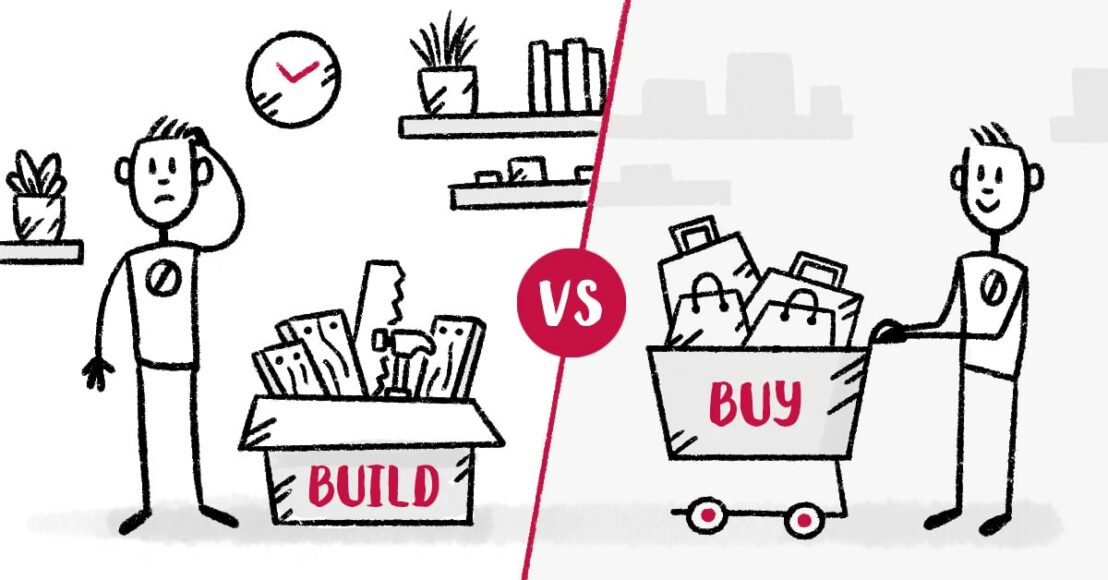During the course of developing a brand new product or adding a specific feature to an existing solution, a question that constantly arises is should we leverage a third party SaaS solution (think Twilio SMS, Stripe Payments, SendGrid Emails) or build a custom solution?
TL;DR
There pros and cons to each approach. Ultimately the decision lies on a myriad of factors including the feature itself, requirements for said feature, client’s timeline, and roadmap. There are circumstances where client requirements are unique which necessitate a custom solution, while other times a third party solution makes more sense in light of the timeline, budget, and overall requirements. Regardless, a typical software stack for an app consist of both custom and third party solutions and this decisions process is a necessary part in the process software development.
Summary
In the dynamic world of application development, businesses often face a critical decision: whether to acquire third-party software or develop custom solutions to incorporate specific features into their applications. This choice has far-reaching implications for functionality, cost, and user experience. In this article, we delve into the pros and cons of each approach to help businesses make informed decisions when it comes to tailoring specific features within their apps.
Leveraging Third-Party Software
Pros
- Rapid Integration: Incorporating third-party software into your app can expedite the process, allowing you to introduce new features quickly. This is especially valuable when you need to respond promptly to market demands or changing user preferences.
- Cost Savings: Acquiring off-the-shelf solutions can often be more cost-effective than developing custom features from scratch. Licensing fees or subscription models might be more budget-friendly than allocating resources for custom development.
- Expertise and Features: Established third-party solutions often come with a wealth of expertise and well-polished features. This allows you to provide users with sophisticated functionalities without extensive in-house development efforts.
- Minimal Maintenance: Vendors of third-party software typically offer ongoing support, updates, and bug fixes. This can reduce the burden of continuous maintenance on your development team.
Cons
- Limited Customization: While third-party software provides valuable features, customization options can be limited. Your app’s flexibility might be constrained, and you may need to adjust your processes to fit the software’s capabilities.
- Vendor Dependency: Relying on external vendors means your app’s functionality is tied to their performance and commitment. If they experience issues, your app might suffer as well.
- Data Security and Privacy: Integrating third-party solutions involves sharing sensitive data with external providers, potentially raising concerns about data security and privacy compliance.
Building Custom Solutions
Pros
- Tailored Precision: Custom-developed features allow you to tailor your app exactly to your requirements. This ensures optimal user experiences and seamless integration with existing processes.
- Competitive Edge: Custom features can provide a unique selling proposition, differentiating your app from competitors and attracting users seeking specialized functionalities.
- Scalability and Flexibility: Custom solutions can be designed to scale efficiently as your user base grows. Additionally, you can tweak and adapt your features over time to suit evolving user needs.
- Complete Ownership: When you build custom solutions, you maintain complete ownership and control over the feature’s architecture, data management, and future updates.
Cons
- Higher Investment: Custom development involves substantial initial investment in terms of time, resources, and funding. This might be a challenge for businesses with tight budgets or time-sensitive projects.
- Extended Development Time: Developing custom features takes time. This could potentially delay the introduction of the feature to the app, affecting your competitive advantage.
- Technical Expertise Requirement: Crafting custom solutions demands a skilled development team with diverse technical expertise. Finding, retaining, and supporting such a team can be demanding.
- Maintenance and Support: After deployment, maintaining, updating, and debugging the feature becomes your responsibility. This could translate to ongoing costs and resource allocation.
Making an Informed Choice
The decision between integrating third-party software and building custom features hinges on multiple factors, including time, budget, product roadmap, and feature requirements. Rapid deployment and cost-effectiveness can drive you toward third-party solutions, whereas the need
for tailored precision, scalability, and ownership might push you to opt for custom development.
Conclusion
Incorporating specific features into your app requires careful consideration of your business goals, user expectations, and resource availability. Whether you choose off-the-shelf solutions or custom development, the ultimate goal is to enhance user experiences and drive the success of your application. By assessing the trade-offs and aligning your choice with your strategic objectives, you can confidently tailor your app’s features to meet the evolving demands of your target audience.


